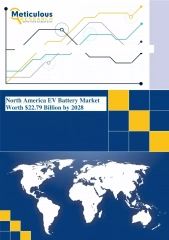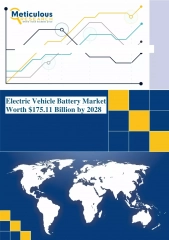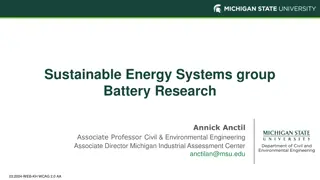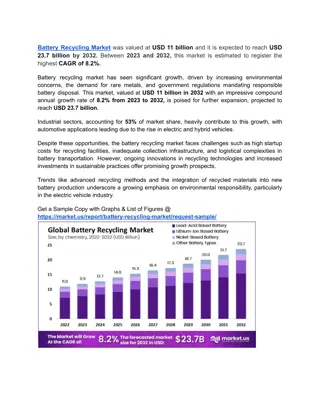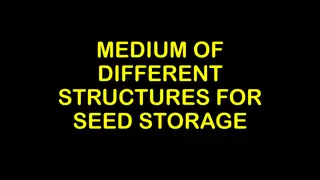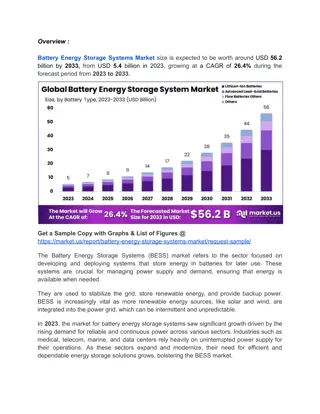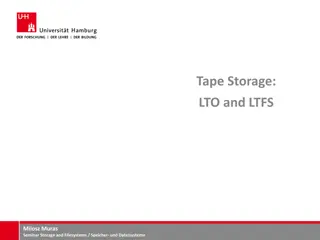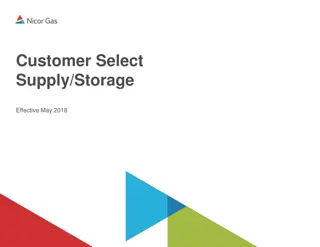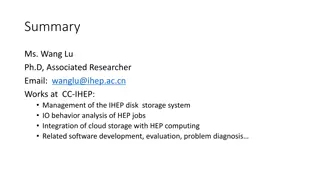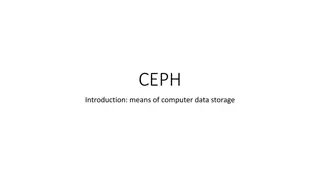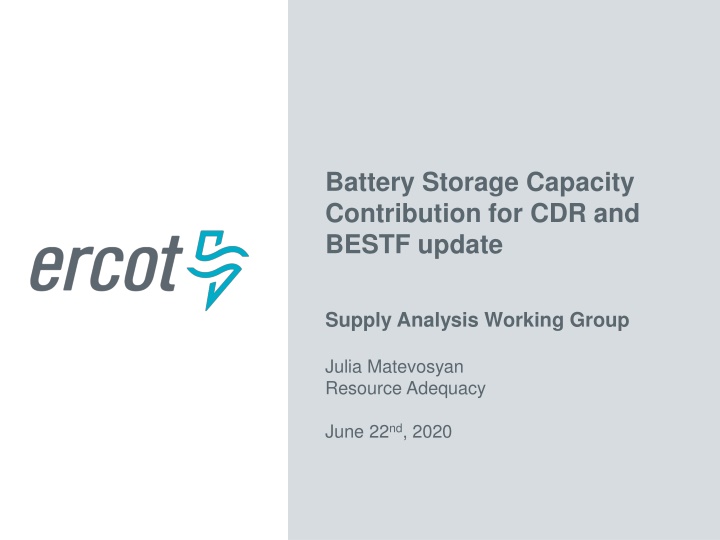
Battery Storage Capacity Contribution Research
Research studies from NREL, LBNL, EPRI, and ICF investigate storage capacity contribution for CDR and BESTF update supply analysis. The ongoing research reviews different methodologies and findings related to storage duration, discharge capacity, and contribution to peak net load hours, as well as the current situation and future proposals for evaluating storage capacity contribution in ERCOT. Updates on planned and existing battery storage capacities are also discussed.
Download Presentation

Please find below an Image/Link to download the presentation.
The content on the website is provided AS IS for your information and personal use only. It may not be sold, licensed, or shared on other websites without obtaining consent from the author. If you encounter any issues during the download, it is possible that the publisher has removed the file from their server.
You are allowed to download the files provided on this website for personal or commercial use, subject to the condition that they are used lawfully. All files are the property of their respective owners.
The content on the website is provided AS IS for your information and personal use only. It may not be sold, licensed, or shared on other websites without obtaining consent from the author.
E N D
Presentation Transcript
Battery Storage Capacity Contribution for CDR and BESTF update Supply Analysis Working Group Julia Matevosyan Resource Adequacy June 22nd, 2020
Research Study Findings (NREL, LBNL, EPRI, ICF) Storage capacity contribution is still a topic of ongoing research ERCOT has reviewed storage capacity contribution studies carried out by the National Renewable Energy Laboratory (NREL), Lawrence Berkeley National Laboratory (LBNL), Electric Power Research Institute (EPRI) and ICF International (ICF) NREL s, EPRI s and ICF s studies all included ERCOT system as one of their test cases Even though the methods used in the studies are different, the conclusions are generally very similar 2 PUBLIC
Research Study Findings (NREL, LBNL, EPRI, ICF) Storage capacity contribution depends on its duration and intended use (i.e. AS or energy arbitrage or both). Storage duration is determined as maximum energy divided by maximum discharge capacity. Based on the studies, storage with sufficient duration is expected to contribute with 100 % capacity over peak net load hours. The width of the net load peak is system-specific but as more storage is added to a system the width of peak net load will increase. Thus, for storage of a given duration there will be a maximum installed capacity after which it is no longer contributing 100% over the entire duration of the net load peak. 3 PUBLIC
Current Situation Based on 05/31/2020 GIS Report: 153 MW of installed battery storage capacity 643 MW with SGIA and Financial Security Posted 100 MW with SGIA 109 MW of planned DGRs almost 7 GW of battery storage (with FIS started) in the interconnection queue with COD before mid-2023 . about 1 GW of those have COD before summer 2021 4 PUBLIC
Current Situation and BESTF Impact ERCOT currently uses 0% capacity contribution for battery storage ERCOT currently does not collect data on storage duration (h) or maximum energy (MWh). This data will be available once NPRR1002 Energy Storage Resource Single Model Registration and Charging Restrictions in Emergency Conditions and RRGRR023 are approved and implemented in RIOO-IS, and Resource Entities update their resource information. NPRR1002 and RRGRR023 are currently on track for August BOD approval RIOO-IS implementation is expected by Q4 2021 5 PUBLIC
Storage Capacity Contribution: Proposed Way Forward ERCOT proposes to evaluate storage capacity contribution based on historic performance over peak load hours (or peak net load hours), similarly to wind and solar For this evaluation storage should be divided into groups by duration ERCOT will need storage MWh and duration information prior to RIOO implementation. ERCOT may issue periodic RFI to gain this information for upcoming projects until RIOO implementation RFI should also collect information on intended use, projects that are intended solely for provision of FFR should be excluded from capacity evaluation. 6 PUBLIC
Storage Capacity Contribution: Proposed Way Forward Once a meaningful amount of storage resources becomes commercial (capacity or number of resources threshold?), ERCOT will start including storage for CDR Reserve Margin calculation purposes. ERCOT will file an NPRR documenting the methodology for calculating storage capacity contribution: Using historic data, ERCOT will be calculating historic average capacity contributions across peak load hours and net load peak hours, similarly to wind and solar. ERCOT then adjust the capacity contribution of storage in accordance with historic performance 7 PUBLIC
Self-Limiting Facilities and Self-Limiting Resources NPRR1026 BESTF-7 Self-Limiting Facilities and Self- Limiting Resources at July PRS for language review. Self-Limiting Facility Multiple GRs or ESRs at the same POI with a limit on combined maximum MW injection and/or withdrawal that is less than installed capacity of these Resources.* Self-Limiting Resource A GR or ESR with a limit on its maximum MW Injection and/or withdrawal which is less than the installed capacity of the Resource.* ERCOT needs to capture these limits in Resource Adequacy reporting. * This is a summary, not an exact definition as per NPRR1026 8 PUBLIC
DC-Coupled Resources NPRR BESTF-6 DC-Coupled Resources coming up soon DC-Coupled Resources One or more Energy Storage Systems (ESS) combined with one or more wind and/or solar generators behind the same POI, where these combined technologies are interconnected within the site using direct current (DC) equipment. The combined technologies are then connected to the ERCOT grid using the same direct current-to-alternating current (DC-to-AC) inverter(s). RRGRR023 includes additional parameters that will be requested from Self-Limiting Facilities, Self-Limiting Resources and DC-Coupled Resources 9 PUBLIC
Capacity Contribution of DC-Coupled Resources ERCOT proposes to evaluate capacity contribution of DC-Coupled Resources based on historic performance. Once a meaningful amount of such resources becomes commercial (MW or number threshold?), ERCOT will start including DC-Coupled Resources for CDR Reserve Margin calculation purposes. Recent EPRI study on capacity contribution of DC-Coupled Resources (using ERCOT as a test case) has found that it depends on: storage duration storage size in relation to the overall plant size type of other generation in the DC-Coupled Resource (i.e. solar or wind) Method of charging (grid charging or self-charging) Intended use of DC-Coupled Resources (energy only or AS) amount of background solar. For capacity contribution evaluation, it may be necessary to group DC- Coupled Resources based on the above criteria 10 PUBLIC
Co-located vs Standalone Storage Based on 05/31/2020 GIS Report: Almost 7 GW of storage in the interconnection queue About 43% of those are co-located with solar Currently ERCOT does not have information if co-located plants are going to be DC or AC-coupled 11 PUBLIC
References to the Studies EPRI: Energy Storage Capacity Value Estimation, Report 3002013957, January 2019, http://membercenter.epri.com/abstracts/Pages/ProductAbstract.aspx?P roductId=000000003002013491 NREL: The Potential for Battery Energy Storage to Provide Peaking Capacity in the United States, Report, June 2019, https://www.nrel.gov/docs/fy19osti/74184.pdf LNBL: Drivers of the Resource Adequacy Contribution of Solar and Storage for Florida Municipal Utilities, October 2019, https://emp.lbl.gov/publications/drivers-resource-adequacy ICF: Unlocking the Hidden (Capacity) Value in Energy Storage, Whitepaper, 2016 https://www.icf.com/insights/energy/unlocking-the- hidden-capacity-value-in-energy-storage 12 PUBLIC
Thank you! Questions? Julia Matevosyan jmatevosjana@ercot.com PUBLIC
ERCOT: 2018 Form EIA-860 Data - Schedule 3, 'Energy Storage Data' (Operable Units Only) Nameplate Energy Capacity (MWh) Maximum Charge Rate (MW) Maximum Discharge Rate (MW) Nameplate Capacity (MW) Operating Year Calculated Duration (h) Plant Name County Notrees Windpower Pyron Wind Farm LLC Inadale Wind Farm LLC OCI Alamo Solar I ETT Presidio NaS Battery Blue Summit Storage, LLC NRG Elbow Creek Energy Storage Kingsberry Energy Storage System Travis Ector Fisher Nolan Bexar Presidio Wilbarger Howard 36 9.9 9.9 1 4 30 2 1.5 2012 2018 2018 2016 2010 2017 2017 2018 13.6 9.9 9.9 0.3 4 12.6 0.7 3 36 9.9 9.9 1 4 30 2 1.5 36 9.9 9.9 1 4 30 2 1.5 0.4 1 1 0.3 1 0.4 0.4 2 Note: Duration (h) is calculated as Energy Capacity (MWh)/Maximum Discharge Rate (MW) and is not part of Form EIA 860 Data 14 PUBLIC


